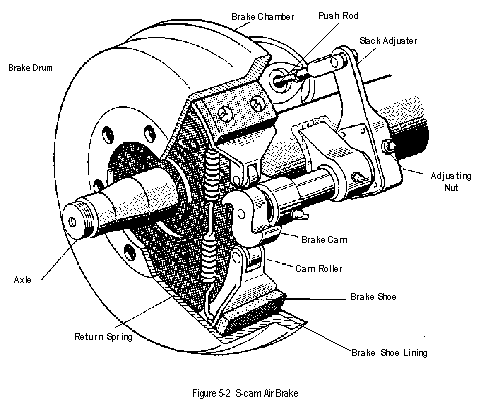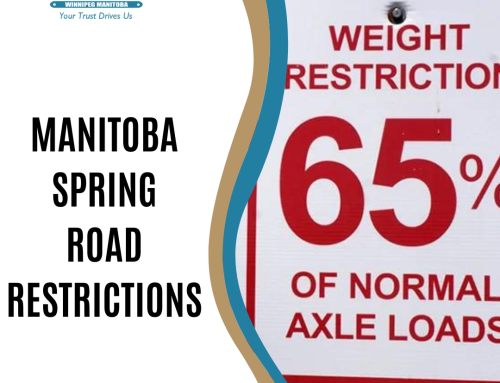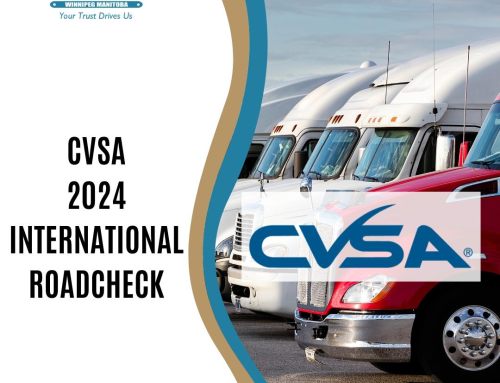
Brake inspections conducted during Brake Safety Week include inspection of brake-system components to identify loose or missing parts, air or hydraulic fluid leaks, worn linings, pads, drums or rotors, and other faulty brake-system components. Antilock braking system (ABS) malfunction indicator lamps also are checked. Inspectors will inspect brake components and measure pushrod stroke where applicable.
Here’s a quick overview of the brake system as well as a checklist of what your looking for during your regular pretrip inspections. If you have any questions about the brake system speak with your maintenance department.
Air Brakes
A quick over view of your airbrake system. We’re not going to go in-depth but let’s hit the highlights.
- The heart of your braking system is the air compressor. It supplies the closed air system with pressured air. Air is stored in tanks on your tractor and feeds a tank on your trailer.
- The compressor is controlled by a governor which keeps the system at its normal operating pressure between 100 and 120 PSI.
- Should your air brake system drop below 55 PSI a warning system, consisting of audible and visual light(s), will engage to alert the operator of low air in the system. Parking brake will apply between 20-40 PSI
- Through a system of valves and relays air is sent to the individual brake pods to control the brakes.
- The Parking brake is applied with a high tension spring. To release the parking break, air is supplied to one of the chambers in the pod to back off the spring and release the brake. Should the system fail and the system losses its air, the brakes apply as the spring applies the parking brake.
- During normal operation air is sent to the individual brakes to slow or stop the vehicle when the vehicle operator presses the brake pedal. Air enters the chamber, the Push Rod travels away from the brake chamber. Referred to as Stroke. The Push Rod is connected to the Slack Adjuster, which connects to and rotates the S Cam and applies the brake.
There’s far more to the system but this is the very basic operation of your brake system.
Test Brakes
When you test your brakes you are testing the whole system. You need to check as part of your pre trip:
Low-air warning device
- Ensure you have air of at least 90 PSI and the ignition is in the ‘On’ position.
- Make brake applications until your low air warnings activate. Warnings should activate at 55 PSI or higher
Air pressure build-up time
- Cut air to your trailer (red valve out)
- Reduce air pressure below 80 PSI
- Maintain 600-900 RPM
- Check the time it takes for the air pressure to raise from 85 PSI to 100 PSI. This time should not exceed two minutes
Air-compressor governor
- Watch the air pressure and note when it ceases to climb (called Cut-Out)
- Reduce air pressure slowly until it begins to climb (called Cut-in)
- Cut-out pressure should not exceed 135 PSI nor be below 100 PSI
- Cut-In pressure should not be less than 80 PSI
Air-loss rate
- Make sure you air pressure is fully charged.
- Turn off your engine
- Release parking break and make a full brake application for one minute
- Note the pressure drop (ignore the initial drop from making the application. Start it from where the pressure stabilizes. Keep a consistent pressure)
- Loss should not exceed 2 PSI for a single vehicle or 4 PSI for a two vehicle combination.
Automatic application of the trailer spring brakes
- Make sure your trailer is being supplied (red valve in)
- Dynamite your trailer brakes (red valve out)
- You should hear the air exit the brake indicating the brakes are set
Spring (parking/emergency) brakes
- Set your parking brakes
- Put the vehicle in gear and add light engine power
- The park brakes should hold the vehicle in place
Air-tank drain valves
- Drain the supply tank until it discharges only clean air
- Drain the remaining air-tanks
- Watch the discharge from the air-tanks and ensure that the drain valves function properly
Checking and Adjusting Brakes and Slack Adjusters
ICBC has a great PDF here with images on how test your brakes and slack adjusters. Keep in mind modern vehicles have Automatic Slack Adjusters and adjusting them manually is a temporary measure.






